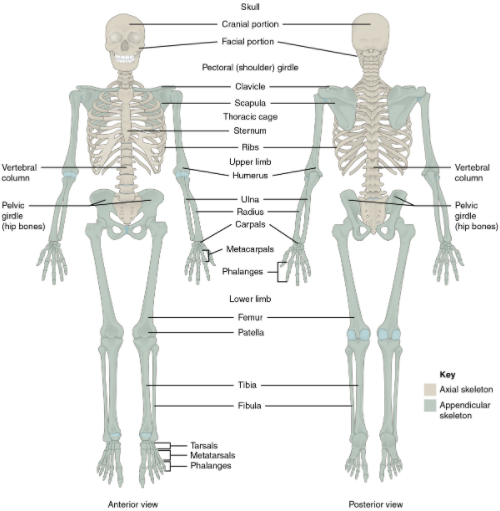
What major organs make up the skeletal system? How can we keep the skeletal system healthy?
Answer
466.5k+ views
Hint: A skeletal system is a group of bones that are arranged in a way to give the body its proper shape. It is the framework of the body. It protects various body organs.
Complete answer:
A newborn baby has 306 bones. Some of these bones join together and strengthen to make a total of 206 bones in adulthood. The skeletal system is composed of two main divisions namely, the axial skeleton and the appendicular skeleton. The major organs that make up the skeletal system are:
-The cranium (skull)
-Spine
-Thoracic cage
-Pelvic girdle
-Upper limbs
-Lower limbs
Of these, the bones of the skull, spine, and thoracic-cage are the part of the axial skeleton whereas the bones of limbs and pelvic girdle belong to the appendicular skeleton. There are other small bones associated with these major organs that together make the 206 bones.

Along with the bones, the other parts that maintain the framework of the human body are ligaments, tendons, and cartilage. The functions of the skeletal system are to provide support to the body, protect the muscular organs like brain, heart, lungs etc.; production of blood cells, storage of minerals, regulation of the endocrine glands.
We must keep our skeletal system healthy by taking the following steps:
-Eat healthy food rich in vitamin A, vitamin B, vitamin C, vitamin D, vitamin K, proteins and fibres.
-Avoid eating oily and fatty foodstuffs.
-Spend at least 30 min for exercise every day.
-Avoid smoking and drinking.
-Maintain a healthy body weight.
Note: The teeth are a part of the skeletal system, but they are not the bones. The smallest bone is ‘stapes’ located in the ear, while the largest bone is ‘femur’, the thigh bone.
Complete answer:
A newborn baby has 306 bones. Some of these bones join together and strengthen to make a total of 206 bones in adulthood. The skeletal system is composed of two main divisions namely, the axial skeleton and the appendicular skeleton. The major organs that make up the skeletal system are:
-The cranium (skull)
-Spine
-Thoracic cage
-Pelvic girdle
-Upper limbs
-Lower limbs
Of these, the bones of the skull, spine, and thoracic-cage are the part of the axial skeleton whereas the bones of limbs and pelvic girdle belong to the appendicular skeleton. There are other small bones associated with these major organs that together make the 206 bones.

Along with the bones, the other parts that maintain the framework of the human body are ligaments, tendons, and cartilage. The functions of the skeletal system are to provide support to the body, protect the muscular organs like brain, heart, lungs etc.; production of blood cells, storage of minerals, regulation of the endocrine glands.
We must keep our skeletal system healthy by taking the following steps:
-Eat healthy food rich in vitamin A, vitamin B, vitamin C, vitamin D, vitamin K, proteins and fibres.
-Avoid eating oily and fatty foodstuffs.
-Spend at least 30 min for exercise every day.
-Avoid smoking and drinking.
-Maintain a healthy body weight.
Note: The teeth are a part of the skeletal system, but they are not the bones. The smallest bone is ‘stapes’ located in the ear, while the largest bone is ‘femur’, the thigh bone.
Recently Updated Pages
Master Class 12 Social Science: Engaging Questions & Answers for Success

Class 12 Question and Answer - Your Ultimate Solutions Guide

Class 10 Question and Answer - Your Ultimate Solutions Guide

Master Class 10 Science: Engaging Questions & Answers for Success

Master Class 10 Maths: Engaging Questions & Answers for Success

Master Class 9 General Knowledge: Engaging Questions & Answers for Success

Trending doubts
Is Cellular respiration an Oxidation or Reduction class 11 chemistry CBSE

In electron dot structure the valence shell electrons class 11 chemistry CBSE

What is the Pitti Island famous for ABird Sanctuary class 11 social science CBSE

State the laws of reflection of light

One Metric ton is equal to kg A 10000 B 1000 C 100 class 11 physics CBSE

Difference Between Prokaryotic Cells and Eukaryotic Cells




